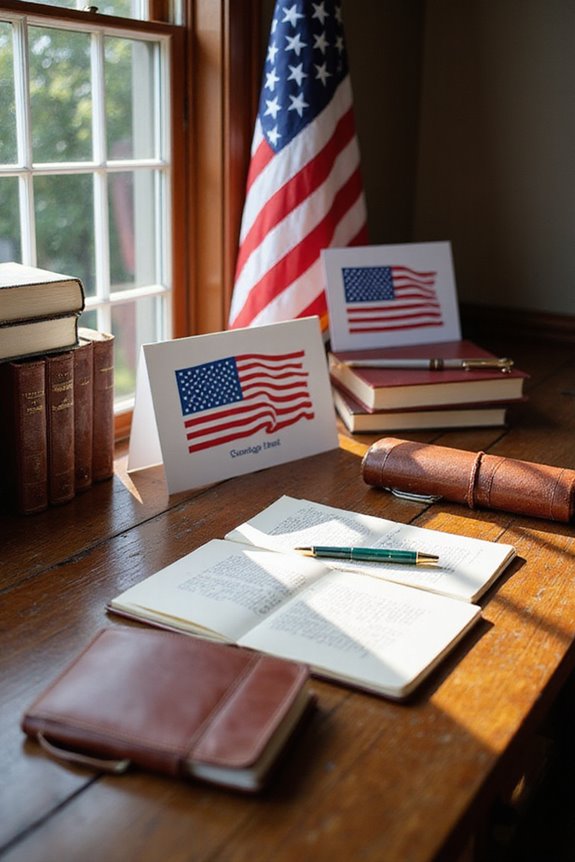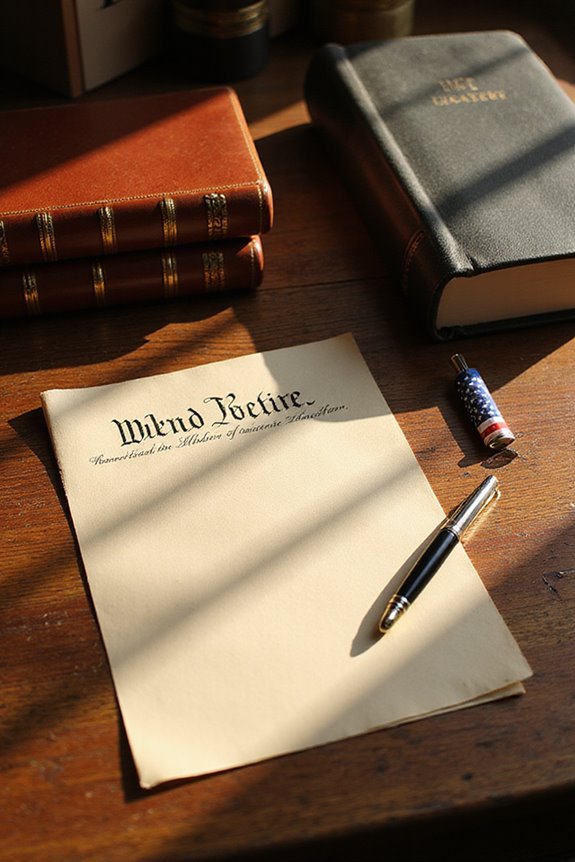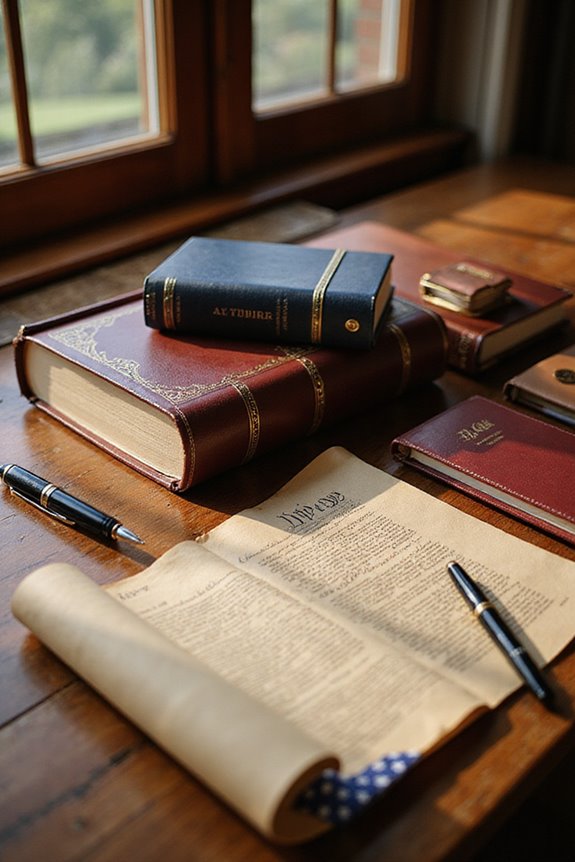To effectively engage volunteers, we should consider essential political stationery options. Here’s a concise overview:
- Direct Mail Postcards: High response rates.
- Brochures: Quick voter education using tri-fold designs.
- Push Cards: Compact format for rallies.
- Campaign Signage: Yard signs enhance visibility.
- Branded Envelopes: Maintain professionalism.
These materials foster clear communication, outreach consistency, and recognition. By optimizing design and messaging, we can greatly enhance campaign efforts. Further details await.
Key Takeaways
- Political Direct Mail Postcards: Use postcards for effective outreach, as they have a higher response rate compared to email newsletters.
- Push Cards and Palm Cards: Provide compact, clear messaging for volunteers to distribute at rallies and events, enhancing visibility.
- Campaign Signage: Invest in yard signs and banners to increase name recognition and visibility in key areas.
- Brochures and Flyers: Distribute tri-fold brochures for quick voter education and to keep volunteers well-informed.
- Personalized Envelopes and Letters: Utilize branded envelopes for professional communication, making volunteers feel valued and connected to the campaign.
Essential Types of Political Stationery
When it comes to political campaigns, having the right types of stationery can greatly enhance our outreach efforts. Here are some essential stationery types we should consider for effective volunteer engagement:
- Political Direct Mail Postcards: These reach our target audience with accuracy. They can be customized for storytelling or persuasion. Direct mail postcards have a 37% higher response rate than email newsletters, making them a powerful tool in our campaign. Using high-quality materials and effective designs can further increase their impact.
- Brochures and Campaign Flyers: Tri-fold brochures provide in-depth information and are easy to distribute at events for quick voter education.
- Push Cards and Palm Cards: Compact and ideal for rallies, they help maintain supporter interest with clear campaign messages.
- Campaign Signage: Yard signs boost name recognition, while banners increase visibility in public spaces.
- Envelopes and Letters: Branded materials add professionalism and can convey official communications effectively.
Utilizing these stationery types can profoundly impact our campaign’s success.
Key Features for Effective Engagement
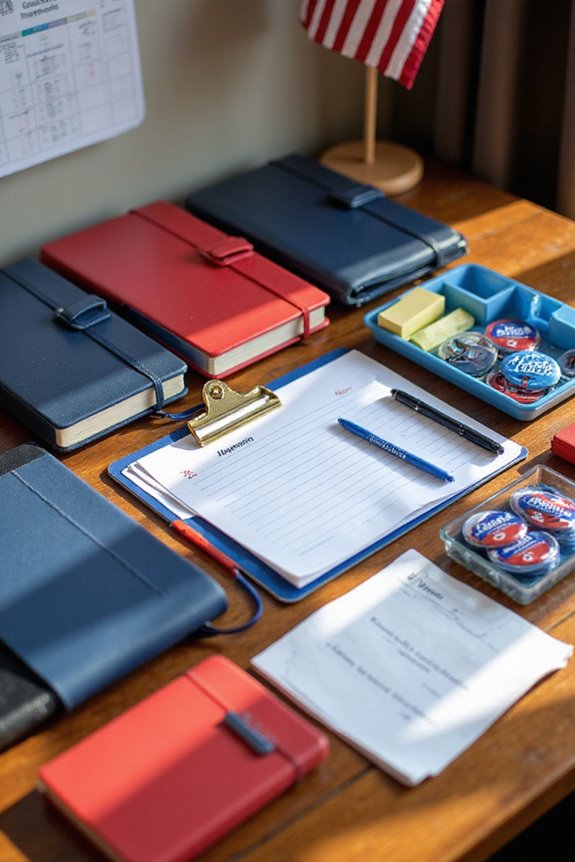
To effectively engage volunteers, we must prioritize key features that foster commitment and enhance their overall experience. Here are essential elements to contemplate:
- Consistent Communication: Regular updates create a sense of belonging and keep volunteers informed about their impact.
- Clear Expectations: Defining roles and time commitments prevents burnout and promotes sustained involvement. Roles and responsibilities dictate volunteer schedules and communication styles.
- Recognition and Appreciation: Acknowledging volunteer efforts increases motivation and loyalty within the team.
- Ongoing Training: Providing support guarantees volunteers feel confident and capable in their roles.
- Alignment with Values: Connecting tasks with personal values boosts engagement and commitment considerably.
Lastly, implementing effective engagement strategies and actively seeking volunteer feedback will enhance our approach, guaranteeing a more fulfilling experience for everyone involved in the campaign.
Tools to Enhance Volunteer Involvement
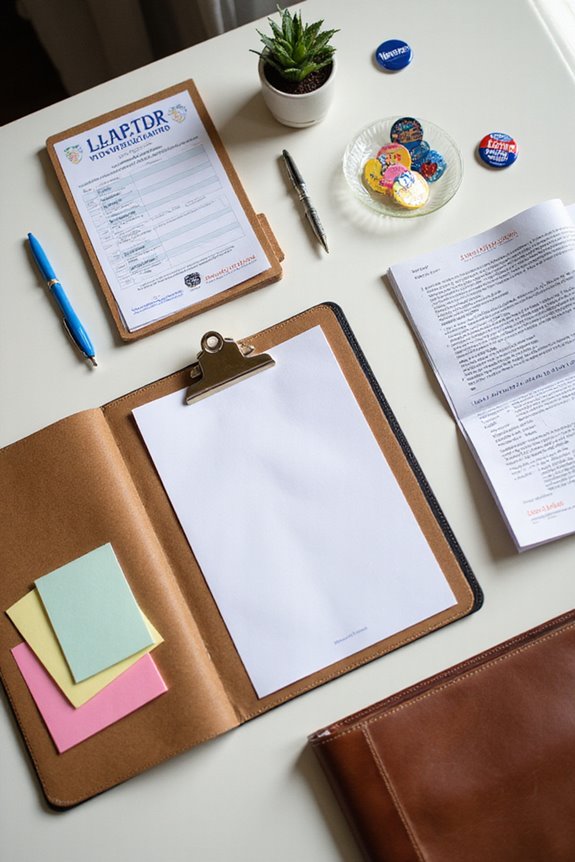
Enhancing volunteer involvement requires a strategic approach to the tools we utilize for recruitment, training, communication, and recognition. Here are some essential tools to evaluate:
- Digital Platforms: Streamline sign-up and tracking, making participation easier. Timeliness of information is essential to keep volunteers engaged and informed about upcoming events.
- Personalized Outreach: Utilize email campaigns and SMS to boost recruitment rates.
- Social Media Tools: Engage diverse demographics and promote volunteer roles effectively.
- Centralized Management Systems: Facilitate communication and scheduling seamlessly.
- Recognition Methods: Public acknowledgment and personalized thank-you notes enhance volunteer satisfaction.
- Volunteer Incentives: Small rewards and campaign swag foster belonging and pride. Additionally, effective outreach through campaign communications can significantly enhance volunteer engagement and participation rates.
Popular Printing Options and Services
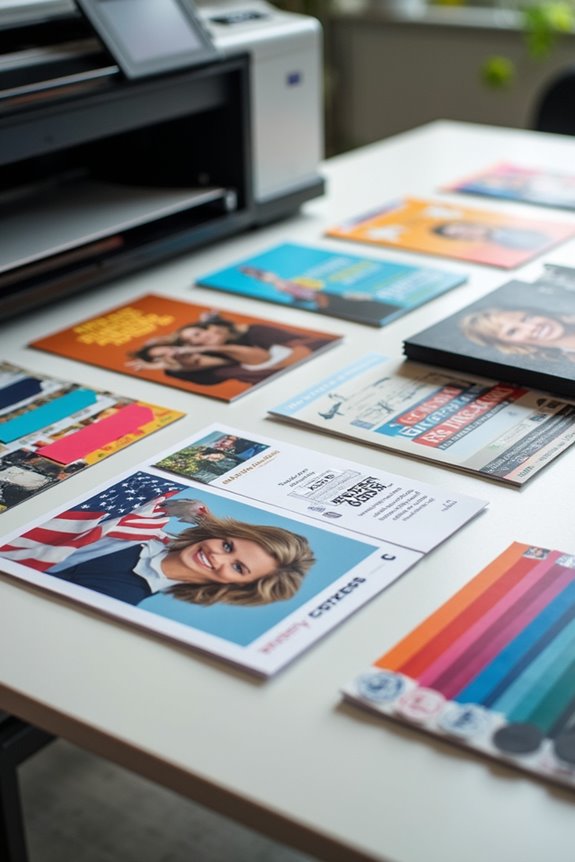
In our quest to optimize volunteer engagement, selecting the right printing options and services for political stationery plays an essential role. Here are some popular printing techniques and material choices that we can consider:
- Cardstock Thickness: Ranges from 10 pt. to 16 pt. for durability.
- Finish Types: Matte, gloss, and high-gloss UV coatings enhance visual appeal.
- Folding Options: Half-fold postcards provide space for detailed messaging.
- Vinyl and Fabric: Ideal for outdoor signage like yard signs and banners. Using high-quality cardstock ensures that printed materials withstand various environmental conditions.
- Custom Sizes and Shapes: Useful for tailored materials like stickers and door hangers.
Additionally, utilizing rush printing options and bulk order discounts can meaningfully streamline our campaigns, ensuring materials are available when needed while staying budget-friendly. Durable paper and cardstock options are essential for creating impactful and lasting campaign materials.
Content That Resonates With Volunteers
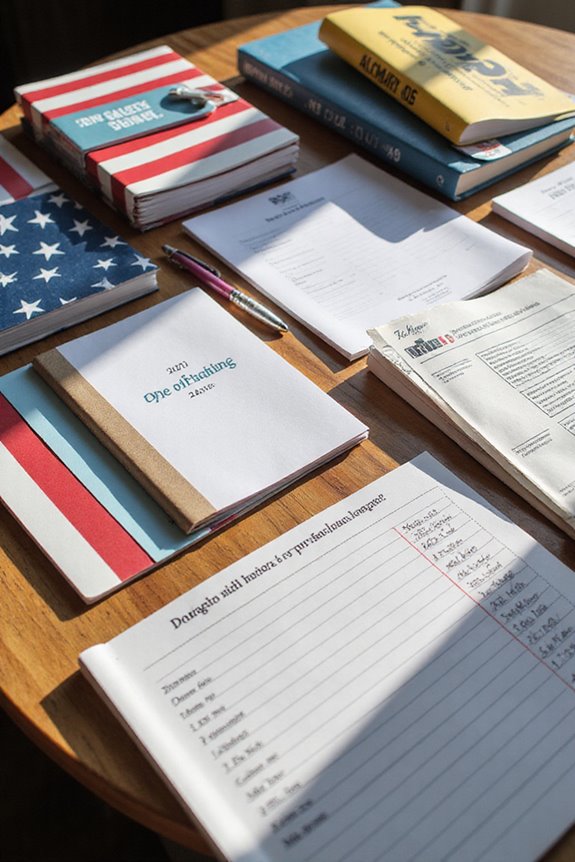
When we consider the content that truly resonates with volunteers, it’s crucial to focus on messages that highlight their significance in the political process. Here are key elements to include:
- Motivational Quotes: Incorporate inspiring statements that reinforce the importance of their contributions, motivating them to stay engaged.
- Personal Narratives: Share stories from current volunteers, illustrating their experiences and emotional connection to the cause, which can inspire others to join.
- Impact Emphasis: Highlight how their efforts directly affect election outcomes and community engagement, making their roles clear and meaningful. For instance, understanding how big data practices influence voter outreach can empower volunteers to see the significance of their interactions. This understanding can be enhanced by exploring historical context that reveals the evolution of political ideas.
- Social Context: Frame volunteering within broader social movements, emphasizing collective impact.
Best Practices for Distribution
Successful distribution of political stationery is essential to maximizing volunteer engagement and outreach efforts. To achieve this, we should adopt several best practices:
- Targeted Outreach: Focus on areas with low voter turnout to guarantee our materials reach those who need them most. This aligns with the League’s goal to improve voter turnout in New York State. Utilizing high-quality materials can also enhance the appeal of our stationery and encourage more engagement.
- Strategic Partnerships: Collaborate with established organizations like the League of Women Voters for guidance and resources.
- Public Spaces: Distribute materials in high-traffic areas, such as libraries and subway stations, to increase visibility.
- Community Events: Attend local events to interact directly with potential voters.
- Material Variety: Offer different types of materials, like stickers and brochures, to cater to diverse preferences. Engaging gifts that promote political awareness can significantly amplify our outreach efforts.
Customization and Design Tips
Effective customization and design of political stationery can greatly enhance our outreach efforts, as it allows us to resonate with voters on a personal level. To achieve this, we should focus on:
- Stationery Personalization: Tailor messaging to specific demographics, including local issues and endorsements from community leaders. Personal touches build trust.
- Design Consistency: Use uniform colors, fonts, and logos to reinforce our campaign brand. High-quality images of candidates and volunteers should be prioritized. Consistent branding across all materials strengthens campaign identity.
- Clear Messaging: Limit text to essential facts, utilizing bullet points for readability. Guarantee a strong call to action directs recipients on next steps.
- Professional Quality: Choose reputable printing services for crisp colors and durable materials, reviewing proofs carefully before mass printing to maintain professionalism.
Incorporating Technology in Stationery
Incorporating technology into our political stationery not only modernizes our outreach efforts but also enhances voter engagement. By integrating digital tools, we can greatly improve interaction with potential voters.
- QR Codes: Adding QR codes to flyers directs voters to campaign websites or donation pages, optimizing engagement.
- NFC Cards: Near Field Communication-enabled cards allow instant sharing of candidate information via smartphones.
- Augmented Reality: Using AR features on posters can display multimedia content, such as video endorsements.
- Online Design Tools: Platforms like Canva enable volunteers to create personalized materials easily, allowing for customization options that cater to specific campaign needs.
- Data Tracking: Scannable codes provide insights into voter metrics, helping us refine our strategies.
Through effective technology integration, we can enhance our campaign’s reach and impact.
Creating a Cohesive Campaign Image
Creating a cohesive campaign image is essential for establishing recognition and trust among voters. To achieve this, we must focus on visual branding and message alignment. Here are key strategies:
- Unified Color Scheme: Establish colors that reflect our campaign values for instant brand recognition.
- Consistent Typography: Use the same fonts and logo placement across all materials to build immediate visual associations.
- Clear Messaging: Repeat slogans and core issues prominently to aid voter recall.
- Coordinated Design Elements: Utilize templates for print materials, maintaining simplicity and legibility. Well-designed postcards serve as a cornerstone for print campaigns, reinforcing our branding strategy.
- Personal Touch: Include personalized messages from the candidate to foster connection.
Strategies for Volunteer Recognition and Motivation
Recognizing and motivating volunteers is essential for maintaining enthusiasm and commitment within our campaign. We can implement effective recognition programs and reward systems to achieve this goal.
- Tangible Recognition: Establish formal awards like “Volunteer of the Month” and send personalized thank-you notes.
- Public Appreciation: Feature volunteers in newsletters and on social media to celebrate their contributions.
- Milestone Celebrations: Acknowledge key achievements, such as reaching 50 volunteer hours, with rewards.
- Incentive Structures: Offer gift cards or exclusive event access for completing specific tasks.
- Gamification: Introduce leaderboards to create friendly competition among volunteers. Effective management lays the foundation for achieving campaign goals and directly impacts campaign outcomes.
- Transparent Criteria: Clearly communicate how recognition and rewards are earned to foster trust.
Frequently Asked Questions
What Size Should My Business Cards Be for Political Campaigns?
Like a well-timed handshake, our business card design should be 3.5″ x 2″ to align with campaign branding. This size guarantees our message resonates, making connections that matter in today’s political landscape.
How Can I Ensure My Door Hangers Are Weather-Resistant?
To guarantee our door hangers are weather-resistant, we should choose durable materials like PVC and apply weatherproof coatings. This combination will protect our message from the elements and enhance longevity for outdoor use.
Are There Specific Colors That Work Best for Political Stationery?
When considering color psychology for our campaign branding, we should focus on colors that evoke trust and excitement. Choosing the right hues can greatly influence voter perception and engagement, making our messages more memorable.
How Can I Track the Effectiveness of My Flyers?
To track our flyers’ effectiveness, we should analyze flyer metrics like distribution counts and audience engagement through QR codes and surveys. This way, we can refine our approach and enhance future campaigns based on real data.
What Materials Are Best for Long-Lasting Stickers?
When considering materials for long-lasting stickers, we should focus on durability factors and adhesive quality. Polyester and laminated options excel in resilience, while vinyl offers versatility. Choosing wisely guarantees our stickers withstand various environments effectively.




